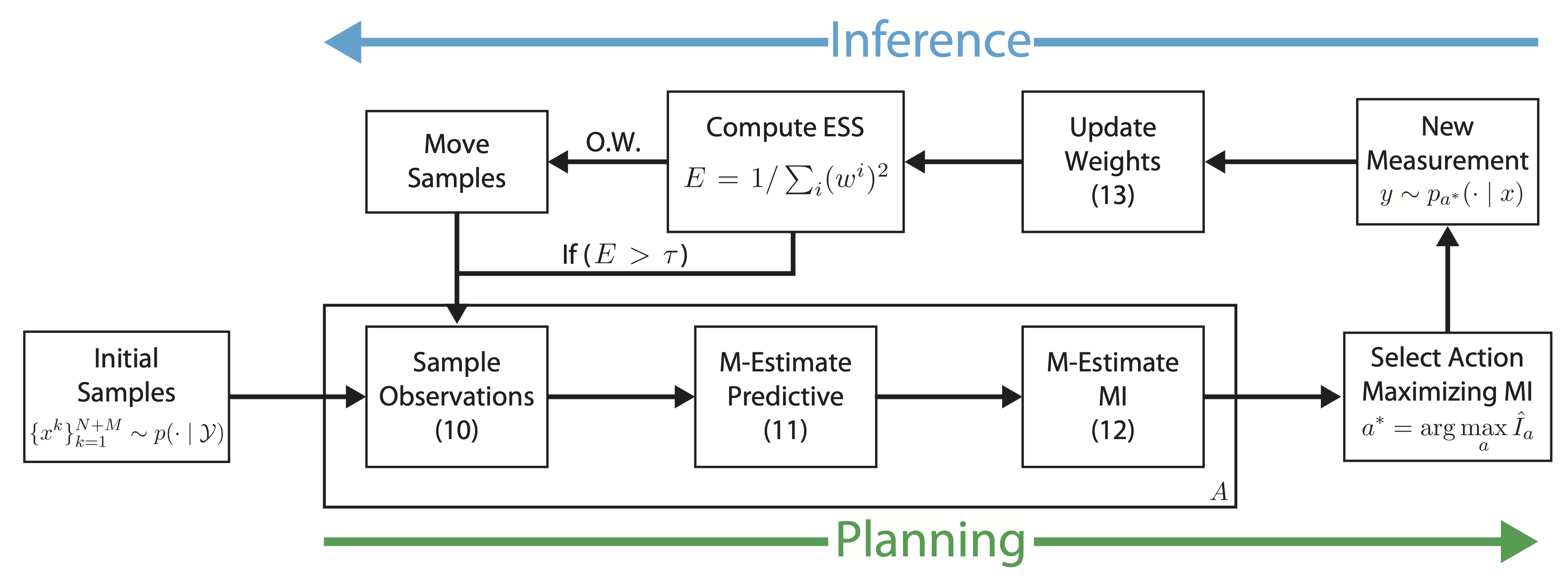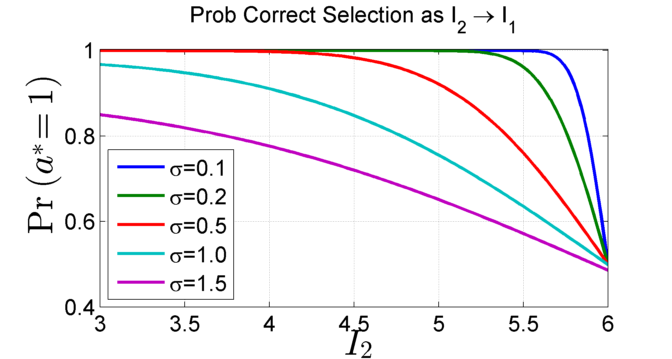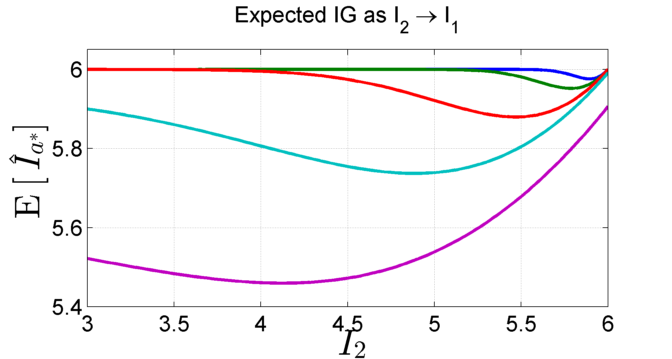Summary: In many sequential planning applications a natural
approach to generating high quality plans is to maximize an
information reward such as mutual information (MI). Unfortunately, MI
lacks a closed form in all but trivial models, and so must be
estimated. In applications where the cost of plan execution is
expensive, one desires planning estimates which admit theoretical
guarantees. Through the use of robust M-estimators we obtain bounds on
absolute deviation of estimated MI. Moreover, we propose a sequential
algorithm which integrates inference and planning by maximally reusing
particles in each stage. We validate the utility of using robust
estimators in the sequential approach on a Gaussian Markov Random
Field wherein information measures have a closed form. Lastly, we
demonstrate the benefits of our integrated approach in the context of
sequential experiment design for inferring causal regulatory networks
from gene expression levels. Our method shows improvements over a
recent method which selects intervention experiments based on the same
MI objective. In our analysis we:
- formulate the estimator bias,
- establish a central limit theorem and consistency,
- show probabilistic bounds of estimator deviation for finite samples,
- and present a probabilistic statement of plan quality.
Related SLI papers: The work of Ertin et al formulating MI in
dynamic sensor query problems Ertin 2003, Williams et al
formulating information-driven sensor planning as constrained
optimization Williams 2007, and Siracusa et al on
Bayesian structure inference Siracusa 2009.
We derive a sequential algorithm is motivated by sequential
importance sampling (IS) for static models introduced by Chopin
2002; a special case of resample-and-move for dynamical systems
(Gilks & Berzuini 2001). Drovandi et al. 2014 propose a similar
approach for experimental design in model selection, though they only
consider discrete observations and rely on the standard IS estimate of
the model evidence. It requires \(N\) posterior samples at each stage
\(t\) and for each action \(1,…,A\) an additional \(M\) posterior samples are
needed. Sample complexity is thus \(O\left(TNAM\right)\). As a practical
alternative we propose a sequential importance sampling approach that
encourages sample reuse thereby reducing computation.

|
|
Sequential Algorithm: Our algorithm
performs closed-loop greedy planning by alternating inference and
planning stages. Planning:
samples \(y^i \sim p_a\) are drawn for each potential action \(a = 1, ... , A\),
followed by robust importance-weighted MI estimates. Note that
planning estimates can be computed in parallel for all actions. Inference: After selecting action \(a^∗ =
\arg \max_{a} \hat{I}_a\) an observation is drawn from the corresponding model \(y \sim
p_{a^∗}\left(y | x\right)\). Importance weights are then updated and new posterior
samples are drawn if the effective sample size (ESS) drops below the
threshold \(\tau\) . Numbers reference corresponding equations in the
main text.
|
Estimator Quality versus Correct Selection: The method relies on the use of a
robust estimator. The figure below show that as the ability to
determine the precise ordering of information rewards for each
action decreases, so does the regret, i.e., the difference in the
reward as a consequence of making an incorrect choice.

|

|
|
Left: Probability of correct ranking:
We vary \(I_2\) from \(I_3\) to \(I_1\) where \(I_1, I_3, I_4, I_5 = 6,
3, 2, 1\) respectively. As \(I_2\) approaches \(I_1\), the probability
of selecting the correct optimizer \(\mathbb{P}(a^* =1)\), which depends on \(\left(I_1 - I_2\right)/\sigma\),
drops as there is increasing chance of selecting \(a^* = 2\).
Right: Expected information gain: While the probability of
selecting the correct maximizer decreases as \(I_2 \rightarrow I_1\),
these actions have increasingly similar IG and the net
reduction in expected IG for choosing the incorrect optimizer
is small.
|
Application to Causal Gene Regulatory Networks: Here the goal is
to plan a sequence of so-called knock out experiments (i.e.,
interventions) in order to discover causal relations between
expressed genes.

|
|
Regulatory network planning: The true network
structure shows edges labeled by weights \(w_{ij}\) (left). The
magnitude of the node mean in true network in the absence of any
intervention (center-left) correlates strongly with selection
sequence by Robust (center) since zeroing the expression level of a
highly expressive gene is expected to induce large
changes. Interventions chosen under Robust and Cho et al
(center-right) from 50 trials. At early iterations Robust selects
interventions consistently across trials whereas Cho et al’s method
exhibits greater variability in the selection process. In both,
greater variance is seen at later iterations when the optimal choice
diverges across trials due to differences in selection history and in
realized observations. The average performance gain realized after
performing the specified intervention at \(t = 1\) (right) indicates
that clamping node 6 is by far the optimal choice.
|
References
[1]
Michael R. Siracusa, John W. Fisher III;
"Tractable bayesian inference of time-series dependence structure," in Proceedings of the Twelfth International Conference on Artificial Intelligence and Statistics,
2009.
[
2]
Jason L. Williams, John W. Fisher III, Alan S. Willsky;
"
Approximate dynamic programming for communication-constrained sensor network management," in
IEEE Transactions on Signal Processing,
2007.
[pdf]
[3]
Emre Ertin, John W. Fisher III, Lee C. Potter;
"Maximum mutual information principle for dynamic sensor query problems," in Proceedings of the 2nd International Workshop on Information Processing in Sensor Networks,
2003.
[4]
C. C. Drovandi, J. M. McGree, A. N. Pettitt;
"A sequential monte carlo algorithm to incorporate model uncertainty in bayesian sequential design," in JCGS,
2014.
[5]
N. Chopin;
"A sequential particle filter method for static models," in Biometrika,
2002.
[6]
W. R. Gilks, C. Berzuini;
"Following a moving target—monte carlo inference for dynamic bayesian models," in JRSS(B),
2001.




